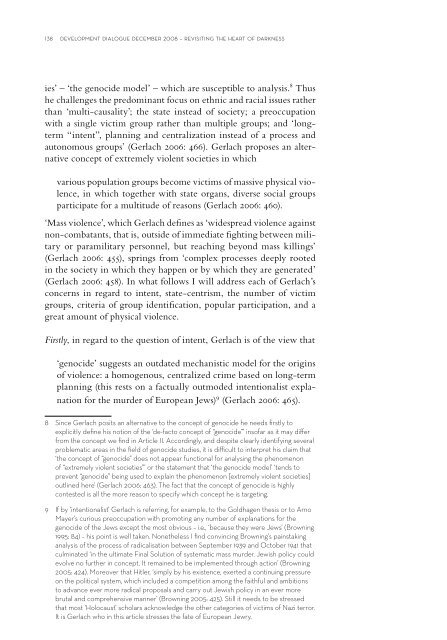60 years after the UN Convention - Dag Hammarskjöld Foundation
60 years after the UN Convention - Dag Hammarskjöld Foundation
60 years after the UN Convention - Dag Hammarskjöld Foundation
You also want an ePaper? Increase the reach of your titles
YUMPU automatically turns print PDFs into web optimized ePapers that Google loves.
138 development dialogue december 2008 – revisiting <strong>the</strong> heart of darkness<br />
ies’ – ‘<strong>the</strong> genocide model’ – which are susceptible to analysis. 8 Thus<br />
he challenges <strong>the</strong> predominant focus on ethnic and racial issues ra<strong>the</strong>r<br />
than ‘multi-causality’; <strong>the</strong> state instead of society; a preoccupation<br />
with a single victim group ra<strong>the</strong>r than multiple groups; and ‘longterm<br />
“intent”, planning and centralization instead of a process and<br />
autonomous groups’ (Gerlach 2006: 466). Gerlach proposes an alternative<br />
concept of extremely violent societies in which<br />
various population groups become victims of massive physical violence,<br />
in which toge<strong>the</strong>r with state organs, diverse social groups<br />
participate for a multitude of reasons (Gerlach 2006: 4<strong>60</strong>).<br />
‘Mass violence’, which Gerlach defi nes as ‘widespread violence against<br />
non-combatants, that is, outside of immediate fi ghting between military<br />
or paramilitary personnel, but reaching beyond mass killings’<br />
(Gerlach 2006: 455), springs from ‘complex processes deeply rooted<br />
in <strong>the</strong> society in which <strong>the</strong>y happen or by which <strong>the</strong>y are generated’<br />
(Gerlach 2006: 458). In what follows I will address each of Gerlach’s<br />
concerns in regard to intent, state-centrism, <strong>the</strong> number of victim<br />
groups, criteria of group identifi cation, popular participation, and a<br />
great amount of physical violence.<br />
Firstly, in regard to <strong>the</strong> question of intent, Gerlach is of <strong>the</strong> view that<br />
‘genocide’ suggests an outdated mechanistic model for <strong>the</strong> origins<br />
of violence: a homogenous, centralized crime based on long-term<br />
planning (this rests on a factually outmoded intentionalist explanation<br />
for <strong>the</strong> murder of European Jews) 9 (Gerlach 2006: 465).<br />
8 Since Gerlach posits an alternative to <strong>the</strong> concept of genocide he needs fi rstly to<br />
explicitly defi ne his notion of <strong>the</strong> ‘de-facto concept of “genocide”’ insofar as it may diff er<br />
from <strong>the</strong> concept we fi nd in Article II. Accordingly, and despite clearly identifying several<br />
problematic areas in <strong>the</strong> fi eld of genocide studies, it is diffi cult to interpret his claim that<br />
‘<strong>the</strong> concept of “genocide” does not appear functional for analysing <strong>the</strong> phenomenon<br />
of “extremely violent societies”’ or <strong>the</strong> statement that ‘<strong>the</strong> genocide model’ ‘tends to<br />
prevent “genocide” being used to explain <strong>the</strong> phenomenon [extremely violent societies]<br />
outlined here’ (Gerlach 2006: 463). The fact that <strong>the</strong> concept of genocide is highly<br />
contested is all <strong>the</strong> more reason to specify which concept he is targeting.<br />
9 If by ‘intentionalist’ Gerlach is referring, for example, to <strong>the</strong> Goldhagen <strong>the</strong>sis or to Arno<br />
Mayer’s curious preoccupation with promoting any number of explanations for <strong>the</strong><br />
genocide of <strong>the</strong> Jews except <strong>the</strong> most obvious – i.e., ‘because <strong>the</strong>y were Jews’ (Browning<br />
1995: 84) – his point is well taken. None<strong>the</strong>less I fi nd convincing Browning’s painstaking<br />
analysis of <strong>the</strong> process of radicalisation between September 1939 and October 1941 that<br />
culminated ‘in <strong>the</strong> ultimate Final Solution of systematic mass murder. Jewish policy could<br />
evolve no fur<strong>the</strong>r in concept. It remained to be implemented through action’ (Browning<br />
2005: 424). Moreover that Hitler, ‘simply by his existence, exerted a continuing pressure<br />
on <strong>the</strong> political system, which included a competition among <strong>the</strong> faithful and ambitions<br />
to advance ever more radical proposals and carry out Jewish policy in an ever more<br />
brutal and comprehensive manner’ (Browning 2005: 425). Still it needs to be stressed<br />
that most ‘Holocaust’ scholars acknowledge <strong>the</strong> o<strong>the</strong>r categories of victims of Nazi terror.<br />
It is Gerlach who in this article stresses <strong>the</strong> fate of European Jewry.

















